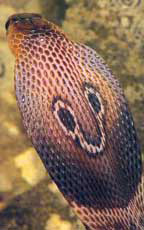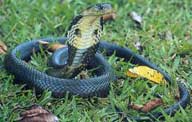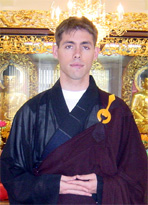Home » Literature Archives » The Cobra Spirit
THE COBRA SPIRIT
by Yin Shan Shakya

Of all the strange and mysterious forms of serpent devotion practiced around the world, Thai Buddhism's Tattoo Festival seems to me to be the most fascinating.
While visiting Thailand's splendid temples some four years ago, I was told about this festival by a monk I met at Wat Phra Kaew, popularly called the Emerald Buddha Temple. "People come from every province in Thailand," he said, adding confidentially, "because there is no surer way to rid yourself of an evil spirit or, for that matter, to acquire a protective one."
I did not feel the need to be exorcized; but since a traveler can always use a good guardian angel-spirit, I determined to attend the festival. The place to go, I was told, was Wat Bang Phra in the town of Nakohn Chaisri which has been, every February since 1975, the brightest star in the tattooing firmament. For it was there that Luang Phor Pern, Abbot of Wat Bang Phra, performed his special magic. Using as his medium ink that has been infused with snake venom and Chinese herbs, and a sixteen inch split metal syringe with sharp needle tips, the Abbot elevated tattooing to a mystical art.
The atmosphere was not one of Spring Cotillions. Converging on the outdoor theater came the possessed and the needy. Construction workers, laborers, gangsters, wanna-be gangsters, and criminals of every possible felony took their place in line and waited, donation in hand, for the ceremony to begin. A crowd that I estimated to number five thousand began to throb and press against the few hundred who waited in mounting frenzy for Abbot Luang Phor Pern to make his dramatic entrance. The minutes passed into hours, the sun rose higher, and the crowd reached its zenith of excitement just as the Abbot finally appeared. The crowd cheered, screamed, and shouted an ecstatic greeting. This kind of reception is usually accorded only champion athletes and movie stars.
Solemnly, the Abbot was escorted to the stage on which he would hold court with his long, ink filled syringes. A chorus of monks gathered on the stage and began to chant rhythmically. The effect of their pulsing cadence was immediate. The mob hysteria settled into mesmerized unity. And then the action started.
The first man to submit to the needles had been harassed by his neighbors. He feared their designs upon his wife, his young daughters, and his little farm. He begs the Abbot to inject into his body the spirit of the great Naga, Muchalinda, the immense cobra who coiled his body seven times around the meditating Buddha and flared his great hood to protect The Blessed One from a violent rainstorm. As the monks chant, the Abbot begins to entwine the man's body with a long blood-puddle that, as an attendant monk blots the serpentine form into recognition, culminates in the center of the man's chest in a hooded, fang-bared cobra's head. The ink does its work and the man begins to hiss and writhe on the ground, raising his chest and turning his head, open mouthed with his lips drawn back to reveal teeth that are ready to bite... incisors, lateral incisors, and canines surround a flicking tongue imitating that of the bifurcated snake tongue, in what are truly terrifying gestures. He flails and slithers uncontrollably as several attendant monks attempt to subdue him. Their efforts are in vain. The man has received the power of the great naga and only exhaustion will bring him to rest.
"What will happen to him now?" I ask a spectator monk who, noticing my shaved head and wooden bead bracelet, speaks candidly. "He'll sleep it off and go home and his neighborhood will buzz with the news that he's someone not to be trifled with. It's all in the belief, isn't it?" he asked. "He believes that the protective strength of the cobra has been put into him and they believe that the protective strength of the cobra has been put into him. As they fear and respect the cobra, they will fear and respect him. And he'll be a better person, too. His body, in a very real sense, is the great Naga's temple."
The tattoo cost the man the equal of fifteen dollars in American money, a cost, that, considering the expected result, would have been cheap at twice the price.
I continued to watch as different tattoos were requested to solve different problems. Some men wanted a tiger; and after being imbued with the ink-essence of this nurturing but ferocious feline, began to growl and leap in perfect imitation of the great beast. The famous Suk roop seua pen, a tiger that Wat Bang Phra is famous for, instills fear and respect into all who view it. A few men wanted Hanuman's agility and wisdom. Upon receiving his permanent image on their body, they began to hoop and howl, jump and paw like monkeys.
Tattoos have been a part of Asian culture for centuries; and in Thailand they have been particularly significant since the reign of King Rama I (1737-809). The king employed tattooed markings to differentiate slaves from freemen: the tattoo would include the person's hometown and the master to whom he belonged. Also, in times long past, as noted in the Thai epic poem Khun Chang Khun Paen, soldiers, preparing for battle, would get tattooed for the protection and strength the inked image would provide. Often whole passages from Buddhist scriptures are tattooed into the flesh of a person so that the wisdom of the lines would be transferred to him.
But the central image has traditionally been the Naga, the Snake, which plays such an important roll in Thai culture. Most Thais are Buddhist and, as such, recognize and respect all life, in particular the snake which feeds upon the rodents that destroy food stores and make domestic life so troublesome. The snake is not regarded in any negative way. Because of Thailand's lush rain forests and warm, humid climate, snakes, cold-blooded creatures, abound in most regions of the country. Two snake species dominate the publics general knowledge of snakes: rattlesnakes which are generally found throughout North, Central, and South America and the famed cobra found throughout Asia and Africa. But of these, one snake receives the most reverence due to its striking characteristics and unforgiving venom, the cobra. In Thailand the Naja naja kaouthia or the Monocled Cobra, is this venerated serpent.
The Monocled Cobra (more accurately termed Monocellated as the hood marking is an occelus) is perhaps the most familiar of the ten subspecies of Asian cobras. They are wide ranging and are quite dimorphic, exhibiting green and yellow to black and white. As all Asian cobras are crepuscular, they are more likely seen basking in the day for warmth When most of us think of cobras, we picture a snake raising its body to meet the threats confronting it; and this posture is characteristic of the Monocled Cobra. This particular animal has developed the most advanced defensive posture of all Asian cobras. As the cobra rears the forepart of its body, the elongated ribs of the cervical area are also raised and the skin stretched over them to create the formidable hood. Hood patterns vary greatly and can have the design of spectacles, hollow discs, single or double monocles (ocelli), or just white bands or wavy lines. Although cobras are solenoglyphous, several species also "spit" or, more accurately, spray venom at intruders to introduce their venom into the mucus membranes of their unsuspecting prey. Although these snakes only achieve four to five feet at maturity, they are treasured for the toxicity of their venom and also because of their startlingly awesome appearance.

Many charming beliefs and folk-tales surround these shy and mostly gentle serpents. The spectacles that dot the back of the cobra's hood are thought to be the fingerprints of the Buddha who blessed the snake after it had shielded him with its hood as he slept in the desert. Asian cobras are also seen as fertility symbols, phallic symbols, and emissaries of various gods. In China, the snake's organs are believed to have medicinal value - the gall bladder, for example, is used for ophthalmic disorders.
As I watched the devotees of the Tattoo Festival I thought about the entrancements experienced by members of other religions, the 'speaking in tongues,' the 'holy rolling' and the fainting when receiving the 'laying on of hands' of faith healers. There may be differences in degree in all of these experiences, but there are not differences in kind. These spiritual responses come from deep within our psyches. A physical alteration of the body such as is seen in the Stigmata may not be fully understood in a Christian society, but it is respected. The physical changes witnessed in these tattooing rituals are likewise mysterious, but they also deserve our respect. Our talismans and good luck charms are as much a part of sympathetic magic as these totem animal tattoos. They all serve a purpose that transcends logic.
It was time to leave the festival. By late afternoon there was an uncountable number of spiritually possessed devotees writhing, jumping, hissing, slithering, clawing, pawing and swaying rhythmically as they advanced towards the source of the chanting music they danced to. The monk beside me pointed to some large monks who had come into the courtyard. "They're the relief guards," he said, "needed especially now when there are so many to oversee. When people are in a trance they are unpredictable and can act out some very dangerous movements. When the animal 'sprit' commands their egoless bodies to act, they can set in motion some violent responses."
I said that the cobra tattoos seemed to inspire the most violent behavior. He agreed. "The relief guards get battle-scarred trying to prevent devotees from getting up on the stage." Then he smiled. "But I met one guard who showed me a really terrible scar he got from one of the cobra people. He was struck and bitten by a man and the scar that the bite left was exactly like a two-fanged snake bite."
I looked back at a few gyrating cobra people. "I can believe it," I said.
Editor's note: Reverend Yin Shan will continue his commentary on the snake as a religious symbol in future essays.

